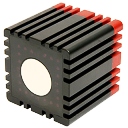|
||||||||||||||||||||||||||||||||||||||||||
|
||||||||||||||||||||||||||||||||||||||||||
Mesa Imaging's Swiss Ranger 4000 - unique, 3D, time-of-flight industrial camera

Go to Swiss Ranger
(SR) 4000
Go
to Standard Resolution Mono Cameras
Go to Mesa
Imaging
Swiss precision provides stable, high-quality, 3D, distance information in demanding environments
 What
is Mesa's time-of-flight
Swiss Ranger 4000 camera and how does it work?
What
is Mesa's time-of-flight
Swiss Ranger 4000 camera and how does it work?
The Swiss Ranger 4000 provides high-resolution 3D image data in
real time.
The device relies on an image sensor technology capable of capturing 3D
data sets (known as depth maps) in real time and is built into a single,
compact, solid-state housing.
At the heart of the camera is an advanced sensor technology employing
the time-of-flight distance measurement principle where infrared light
from the camera's internal lighting source is reflected by objects in
the scene and travels back to the camera where its precise time of arrival
is measured independently by each of tens of thousands of sensor pixels.
Two measurement range models are available up to a distance
of 10 metres. Date is output via USB 2.0 or Ethernet to a computer
for visualisation, interpretation and processing. Various models are available
to be matched to user needs.
| What advantages does Mesa's SR4000 time-of-flight camera have ? |
| Mesa's time-of-flight-based measurements have several important advantages compared to other 3D imaging technologies, such as laser triangulation or stereoscopic vision systems: |
| Measurements are not dependent on external reference points or presence of contrast in the surface of measured objects. |
| Real time, video frame rate measurements independent of scanning cycles or limitations imposed by computer processing power. |
| Scene illumination is provided by the camera, and is not dependent on illumination from external, visible light. |
| Larger objects can be measured easily without any increase in camera base length (as with stereo vision). |
| Camera directly delivers depth values for each pixel, without the need of complex calculation algorithms. This results in faster, less computation intensive systems and allows for direct integration of application algorithms onto the DSP of the camera. |
| Key features of the SR4000 camera | |
| ** | Industrial-grade camera allowing for high-quality measurements in demanding environments. |
| ** | Stable measurements are guaranteed through a self-calibrating optical design |
| ** | Measurement accuracy is independent of object colour and reflectivity |
| ** | In-pixel background light suppression allows for higher measurement accuracy in spite of unfavourable background light conditions |
| ** | Two measurement ranges, 5m and 10m allow more flexibility when balancing measurement range with measurement precision |
| ** | Simultaneous multi-camera measurements possible through access to multiple illumination frequencies (up to 3 cameras) |
| ** | Selectable acquisition mode allows continuous or triggered measurement. Trigger mode allows synchronization with other devices |
Multiple camera models with different measurement ranges and communication
modules are available.
Please contact Adept to discuss your specific requirements.
| Where can I use the Swiss Ranger 4000? |
| Applications include: |
|
| Machine Vision: More general machine vision applications require highly stable and reliable sensory systems. The MESA camera, supplies a reliable set of depth data which increases the robustness and flexibility of many surveillance, inspection, and logistics systems. Specific applications in this field include: | |
| ** | Single-camera-based factory automation via identification of an object's location, volume, and orientation |
| ** | Replacement of space-consuming infrared light curtains used to monitor workers in the proximity of dangerous equipment |
| Robotics: The search for real-time electronic robotic eyes that closely mimic the behaviour of human eyes has been a high priority for some time. The SR400 avoids the shortcomings of alternative solutions such as stereoscopic cameras or laser scanners. One Mesa camera allows a single compact sensor to serve as a highly capable input device in many robotic applications, including: | |
| ** | Autonomously-guided vehicles with improved obstacle identification and avoidance - for map building, localisation and path planning. |
| ** | Service robots in both industrial and consumer applications. |
| ** | Industrial robots in assembly, quality control monitoring, material handling, and automation. |
| Other applications include: | |
| Logistics: For detecting and measuring volumes of freight in a very short time by providing fast data acquisition and a small system size with no need for mechanical scanning devices. | |
| Security / Surveillance: the third dimension delivered by the SR4000 allows for much easier segmentation of images, for example, it allows of determination of presence, location and number of persons or objects in a target zones. | |
| Medical and Biometrics: The ability of the SR4000 camera to provide immediate, cost-effective images enables a diverse set of emerging medical and biometric applications such as: | |
| ** | human-machine interface for geriatric rehabilitation computer games |
| ** | clinical use of Time-of-flight for patient-position and patient-movement monitoring to increase effectiveness of therapy (including radio therapy) |
| ** | Providing laparoscopic surgeons with a surface dimension to assist in endoscopic surgery procedures, enabling the marriage of the real-time image to previously generated scanned images. |
Adept Electronic Solutions are "The Machine Vision and Imaging Specialists" and distributor of Mesa Imaging in Australia and New Zealand. To find out more about any Mesa Imaging product please email us at: adept@adept.net.au or call us at Perth (08) 92425411 / Sydney (02) 99792599 / Melbourne (03) 95555621 or use our online contact us page.
|
If you like this page, please recommend and share it. |
|||
| More | |||



